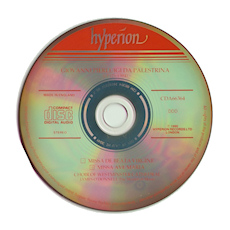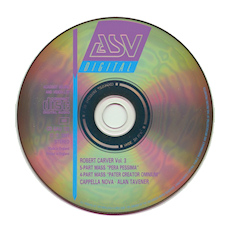
The Internet's Premier Classical Music Source
Related Links
Recommended Links
Site News
Koussevitzky Recordings Society
CD Bronzing
L. David Lampson
September 1995
Not long after the CD was introduced in 1981, questions concerning the longevity of the medium began to arise. Since the mid-eighties, when the CD began to supplant the LP as the primary consumer format for pre-recorded music, rumors of "laser rot" have periodically appeared to challenge industry claims that CDs would remain playable for at least a century or more. All but one rumor have proved groundless; any problems that have occurred have been traced to specific, improperly manufactured batches or releases where a manifest breach of quality control occurred.
One reported fault, however, has rightly continued to concern collectors. In the late 80s and early 90s several hundred titles produced at Philips & Du Pont Optical UK Limited (PDO) were made with a lacquer that was unable to withstand the long-term corrosive effects of the sulphur normally found in paper used for CD booklets and inserts. Lacquer is used as the clear, plastic coating that protects the shiny aluminum layer on which reside the digitized data that are read to produce music. Aluminum is especially susceptible to oxidation when it comes into contact with air. After the aluminum layer of a CD becomes oxidized, it loses the ability to reflect accurately the laser beam that is used to read the digitized data. If the lacquer is porous and allows air or other oxidizing chemicals to come in contact with the aluminum layer, the CD will eventually become unplayable. It is possible that most or even all of the CDs manufactured by PDO during the period of substandard lacquer application will become unplayable in time.
Complete and definitive information has been difficult to obtain, but it has been reported that this problem may be specific to discs manufactured within a 16-18 month period overlapping the turn of the decade from the 1980's to the 1990's. During the defective lacquer interval, PDO was contracted to produce discs for a number of labels, including Hyperion, Pearl, Academy Sound & Vision, CRD, Archiv, Deutsche Grammophon, London/Decca, and Unicorn-Kanchana. Most of the discs made during this period have the words "MADE IN U.K. BY PDO" etched in the inner hub. PDO anticipates problems will develop with discs produced for all of these labels. Collectors who have these labels in their collection should check them for discoloration. Breakdown of the lacquer is characterized by a gradual "bronzing" of the disc starting at the outer edge and creeping inward; usually the bronzing appears first on the label side. (The slight, even yellowish or golden hue that some discs display is entirely normal and should not be confused with fatal bronzing which has a more rust color.) The rate of corrosion is variable, and not every CD of a given release will develop this problem. Eventually affected discs start producing digital errors, especially in the last few tracks, which lie on the outer margins of the disc. (Unlike vinyl records, CDs track from inside to outside.) These errors usually sound like the clicks and pops heard on LPs.
I have spoken with Mrs. Pat Burns at the PDO Helpline. PDO's stated policy is to replace CDs that become defective. Defective discs eligible for replacement are defined either as showing a visually advanced stage of bronzing (with or without audible defect), or as discs having been manufactured by PDO that are audibly defective. PDO has pledged that they will repress new CDs as long as 20 years from now if the customer notices the corrosion problem, so there is no need to act before a deadline. PDO suggests that customers inspect suspect CDs at six-month intervals. [Update 11/15/2007: PDO has changed ownership, and their policies regarding defective product have changed. Please see the Hyperion web site for current information on obtaining replacement discs.]
Please consult the List of Possible Affected Discs for more information.
Customers may contact PDO directly for replacement of eligible discs. Each CD for which a replacement is sought should be identified by label and complete catalog number at the time of replacement request. PDO can be contacted at:
Andrea Hoyle
PDO Helpline
Freepost BK1080
Blackburn
Lancashire
BB1 5BR
UK TEL: 0 800 387063
TEL: +44 1 254 505439
FAX: +44 1 254 263673
Philips & Du Pont Optical UK Ltd.
Philips Road
Blackburn
Lancashire
BB1 5RZ
Though potentially a substantial number of discs were affected, it is important to note that the defects resulted from the use of substandard materials and were not symptomatic of a deficiency in digital compact disc technology itself. Well into the second decade of mass production of CDs, no fault inherent in the medium itself has yet been identified in this product, which was brought to a high state of technological refinement prior to its introduction as a consumer medium.
For additional information on this problem, see the Hyperion Records site.














